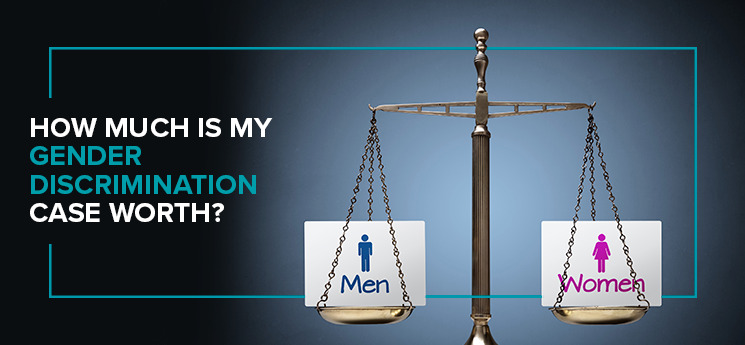The American legal system recognizes a range of discrimination types in the workplace. These laws prohibit discrimination based on many identifying factors, like race, color, age, religious affiliation, national origin and gender.
Gender discrimination is any disadvantageous or unequal treatment of an individual or group based on gender. This type of discrimination may encompass only hiring one gender in a workplace, directing inappropriate comments toward an individual for their gender or getting paid less.
Experiencing discrimination based on gender can lead to lost jobs, wages and benefits. It may even cause mental damages, like depressive episodes. If you feel your employer has discriminated against you for your gender, litigation may be worth your time and effort.
Average Settlement in Gender Discrimination Cases
In litigation, settlement is a resolution for the charges at hand, and it most often comes as a sum of money, although other remedies may also be considered, including reinstatement. Once a settlement is determined, all litigation comes to a close, and the case will not move to court. It is a compromise between the plaintiff and the defendant to end the dispute.
Providing an average for gender discrimination lawsuit settlements is challenging because this information is usually kept private once a case closes. Sometimes, settlement amounts are a matter of public record, like in cases involving the state. Settlement amounts can vary widely.
The settlement agreed upon usually depends on the stakes in a case. Deciding parties will often factor in damages like lost wages and emotional distress to satisfy a plaintiff’s claim of discrimination.
A settlement amount can be offered at any point, and whether a plaintiff accepts depends on whether they feel the value is appropriate. If a lawsuit can lead to extensive damages, a plaintiff and their legal team may not agree to a settlement offer. In some cases, a judge or mediator will help the parties determine a settlement for a case.
Damages for Gender Discrimination
Damages are a sum of money plaintiffs receive following a lawsuit. Damages fall into two categories — compensatory and punitive — that are both possible in a gender discrimination case.
Compensatory Damages
Compensatory damages can cover expenses for economic and non-economic reasons. Economic damages include any out-of-pocket expenses the plaintiff had to cover due to the discrimination. For example, if an employee is wrongfully terminated and has to pay for their own health insurance, this would fall under economic damages. Lost wages and benefits also fall under this category.
Non-economic damages cover compensation for injuries a plaintiff sustained due to the discrimination. These injuries are subjective compared to economic expenses, but they can include mental anguish and loss of enjoyment of life due to workplace discrimination.
Punitive Damages
Punitive damages act as a punishment for the defendant rather than as a reimbursement to the plaintiff. These damages are only an option if the defendant acted with malice or knowingly disregarded rights.
A judge or jury must clearly see this recklessness or gross disregard of the plaintiff’s safety. Under Federal law, there are limits for compensatory and punitive damages based on the company’s size.
What Amount Can I Receive for Damages?
The damages you can receive in a gender discrimination case will vary based on your experience. If you have a clear discrimination case to present, especially if you lost your job and have evident mental anguish, damages can be high. If your employer has a track record of gender discrimination, the chance for punitive damages is also higher.
What Is My Gender Discrimination Case Worth?
The overall worth of your gender discrimination case is hard to gauge. With so many factors contributing to the possible payouts, compensation can vary greatly. When considering the value of your case, think about the following factors:
- The strength of your proof
- Your employer’s insurance policies
- Your employer’s record of discrimination
- The extent of damages caused by the discrimination
- Whether your employer’s behaviors were shocking enough to anger the jury
- Whether your employer has the money to cover settlement or damages
Consulting with a lawyer can help you understand the value of your case, even if you choose to walk away from it. Since calculating a settlement or damage amount for a case depends on various factors, you will need to understand many characteristics of your case. Legal professionals have the experience to ask the right questions and refer to previous cases to determine how your claim may end.
Gender discrimination lawsuit settlement amounts may vary depending on the exact type of case you’re dealing with. For example, a sexual harassment case may attract different amounts than a pregnancy discrimination case. Your lawyer can estimate your case’s value depending on these different case types. Essentially, the term gender discrimination is broad and includes several types of claims. Some forms of gender discrimination in the workplace include:
- Retaliation
- Harassment
- Unequal pay
- Bias and stereotype
- Unequal opportunities
- Pregnancy discrimination
- Hostile work environment
- Promotion and advancement
- Gender identity discrimination
- Unequal dress codes and appearance standards
Considerations
When deciding to take gender discrimination to court, it is essential to consider the time and expenses of litigation. Bureaucratic hurdles may extend the timeline before your case enters a courtroom. A lawyer’s guidance can also help you determine a case’s worth regarding these factors.
You should also consider the evidence you have against your employer. Is it enough to make your case? The quality of your evidence will influence your chances of winning the case.
To succeed and receive most damages available under the U.S. Equal Employment Opportunity Commission (EEOC), you must prove your claim is more likely true than not true. You stand a better chance of winning if you present multiple types of evidence reinforcing your claim.
The EEOC evaluates three types of evidence in these claims — statistical evidence, comparative evidence and direct evidence. These types of evidence can be presented in the following forms:
- Pictures
- Recordings
- Wage records
- Correspondence
- Education records
- Personnel records
- Witness testimony
- Health care records
- Disciplinary records
- Employment agreements
- Employer guides and policies
- Complaint history against the employer
Possible Implications
Discrimination lawsuits are an excellent way to enforce accountability for employers. While a case win may help you recover damages, it also reveals an employer’s illegal behaviors.
Even if you lose a case, this public accountability can lead to changed behaviors. If your employer has a history of poor or unlawful actions, this demand for accountability can be a strong justification for litigation. Initiating action against a biased employer could be the best decision you can make for yourself, your family and the wider community.
Get a Free Consultation
Weisberg Cummings, P.C., specializes in employment law in Pennsylvania to serve those wronged by employers and fellow employees. Our lawyers have over 40 years of combined experience in this area, and we strive to bring our expertise and professionalism to every case.
One of our attorneys is also a certified public accountant (CPA). This factor gives our team in-depth insight into financial damages to help our clients get the appropriate compensation for their cases. We will take the time to understand your situation to provide well-backed legal representation for your gender discrimination case.
Contact us today for a free consultation.




